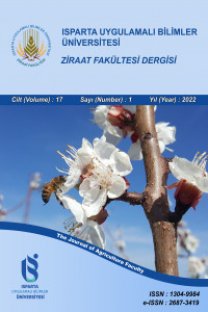The Chemical Composition of Essential Oils of Melissa officinalis subsp. altissima from Turkey
Türkiye'den Melissa officinalis subsp. altissima'nın Esansiyel Yağının Kimyasal Kompozisyonu
___
Adzet, T., Ponz R., Wolf E., Schulte E. 1992. Content and composition of M. officinalis oil in relation to leaf position and harvest time. Planta Med. 58: 562-56Basta, A., Tzakou O., Couladis M. 2005. Composition of the leaves essential oil of Melissa officinalis s. l. fromGreece. Flavour Fragr. J., 20: 642-644.
Bolkent, S., Yanardag R., Karabulut O., Yesilyaprak B. 2005. Protective role of Melissa officinalis L. extract on liver of hyperlipidemic rats: a morphological and biochemical study. J. Ethnopharm., 99:397-398.
Craker, L.E., Simon J.E. 1992. Herbs, Spices and Medicinal Plants: Recent Advances in Botany, Horticulture, and Pharmacology. Volume 2. Oryx Press. USA.
Dawson, B.S.W., Franich R.A., Meder R. 1998. Essential oil of Melissa officinalis L. subsp. altissima (Sibthr. Et Smith). Arcang. Flav Fragr J 3: 167-170.
Geuenich, S., Goffinet C., Venzke S., Nolkemper S., Baumann I., Plinkert P., Reichling J., Keppler O.T. 2008. Aqueous extracts from peppermint, sage and lemon balm leaves displaypotent anti-HIV-1 activity by increasing the virion density. Retrovirology 5:27.
Hohmann J, Zupko I., Redei D. 1999. Protective effects of the aerial parts of Salvia officinalis, Melissa officinalis and Lavandula angustifolia and their constituents against enzymedependent and enzyme independent lipid peroxidation. Planta Med., 1999; 65: 576-578.
Lawrence B.M. 2008. "Progress in Essential Oils. Melissa or Lemon Balm Oil."Perf & Flav. 33 (Sept 2008), 66-70.
Meftahizade H, Sargsyan E., Moradkhani H. 2010. Investigation of antioxidantcapacity of Melissa officinalis L. essential oils. J. Med. Plant Res., 4(14): 1391-1395.
Moradkhani H., Sargsyan E., Bibak H., Naseri B., Sadat-Hosseini M., FayaziBarjin A., Meftahizade H. 2010. Melissa officinalis L., a valuable medicine plant. A review. J. Med. Plant Res., 4: 2753-2759.
Petersen, M., Simmonds, M.S.J. 2003. Molecules of interest: Rosmarinic acid. Phytochem., 62, 121-125.
Ribiero, M.A., Bernardo-Gil M.G., Esquivel M.M. 2001. Melissa officinalis L.: study of antioxidant activity in supercritical residues. J. Supercrit. Fluids. 21:51-60.
Saeb K., Gholamrezaee S. 2012. Variation of essential oil composition of Melissa officinalis L. leaves during different stages of plant growth, Asian Pac. J. Trop. Biol. 547-549.
Schultze, W., König W.A., Hilker A., Richter R. 1995. Melisseno le. Deutsche Apotheker Zeitung, 135, 557-577.
Shalaby, A.S, El-Gengaihi S., Khattab M. 1995. Oil of Melissa officinalis L., as affected by storage and herb drying. J. Essent. Oil Res. 7:667-669.
Tagashira M., Ohtake Y. 1998. A new antioxidative 1,3- benzodioxole fromMelissa officinalis. Planta Med., 64: 555-558.
Tucker, A.O., Debaggio T. 2000. The big book of herbs: a comprehensive illustrated reference to herbs of flavor and fragrance. Loveland, CO: Interweave Press.
Van den Berg T., Freundl E., Czygan F.C. 1997. Melissa officinalis subsp. altissima: characteristics of possibleadulteration of lemon balm. Pharm. 52: 803-808.
Weitzel, C., Petersen M. 2011. Cloning and characterisation of rosmarinic acid synthase from Melissa officinalis L. Phytochem., 72, 572-578.
- ISSN: 1304-9984
- Yayın Aralığı: Yılda 2 Sayı
- Başlangıç: 2006
- Yayıncı: Isparta Uygulamalı Bilimler Üniversitesi
Kumru (Ordu) Yöresinde Doğal Olarak Yetişen Bazı Tıbbi Ve Aromatik Bitkiler
VOLKAN GÜL, BURCU SEÇKİN DİNLER
Ağlasun Orman İçi Meralarının Verim ve Kalitesinin Belirlenmesi
Türkiye'de Ceviz (Juglans regia L.) Araştırmaları
Safder BAYAZİT, Hilal TEFEK, OĞUZHAN ÇALIŞKAN
Aspirde ekim zamanı, çeşit ve verim ilişkisi
Ayva Dilimlerinin Mikrodalga ile Kurutulması
SEVİL KARAASLAN, TUNAHAN ERDEM, Murat SARI
Farklı Gelişme Kuvvetine Sahip 14 Elma Anacının Yapraklarında Fenolik Bileşenlerin Değişimi
Alüminyum ve Kadmiyum Metallerinin Mısır ve Mercimek Tohumlarının Çimlenmesine Etkileri
Erdem YENİ, Kudret KABAR, ASLIHAN CESUR TURGUT
Türkiye’den Melissa officinalis subsp. altissima’nın Esansiyel Yağının Kimyasal Kompozisyonu
Kenan TURGUT, Begüm TÜTÜNCÜ, Esra UÇAR, Yaşar ÖZYİĞİT
Bazı Yerli Elma Çeşitlerinin Pomolojik ve Biyokimyasal Özelliklerinin Belirlenmesi
